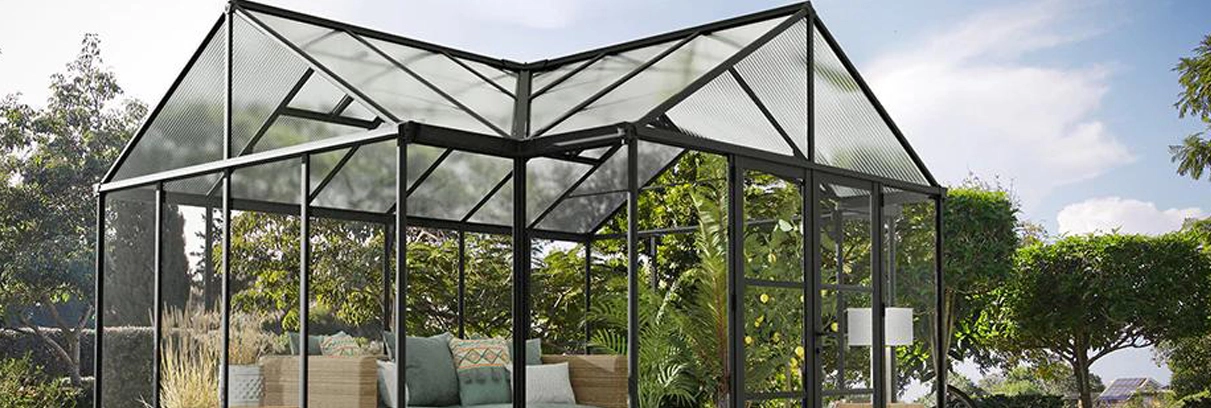Greenhouse glass is a specialized type of glass designed to optimize the growing conditions within greenhouses, enabling a wide variety of plants to thrive regardless of the external climate conditions. This glass is engineered to maximize the transmission of natural sunlight while minimizing heat loss, creating an ideal environment for photosynthesis and plant growth throughout the year.
One of the key features of greenhouse glass is its ability to balance light transmission and insulation. High-quality greenhouse glass allows for maximum sunlight penetration, which is crucial for plant growth, but it also has properties that help retain heat within the greenhouse. This is particularly important during cooler months, as it ensures that the internal temperature of the greenhouse remains stable, promoting year-round growth without the excessive need for artificial heating.
In addition to its thermal properties, some greenhouse glass is treated or coated to protect plants from harmful UV rays while still letting through the full spectrum of light needed for growth. This can help prevent plant burn and reduce the risk of disease, further contributing to the health and productivity of the greenhouse ecosystem. These specialized glass products, including curved greenhouse glass panels, are often manufactured by an industrial glass company that focuses on agricultural and horticultural applications.

1
The benefits of diffuse light in horticultural production have long been debated, and there is growing evidence that using light diffusing technologies in a greenhouse can provide production benefits such as increased yields in edible crops, shorter time to market, and improved ornamental quality.
2
Most of the independent facts about diffusing technologies relate to diffuse glass, so the information below currently concentrates on this approach. However, many of the principles also apply to other methods of producing diffuse light.
Greenhouse glass can have a complex impact on pest control within greenhouses.
Physical Barrier: Greenhouse glass acts as a physical barrier, preventing many outdoor pests like insects, birds, and small animals from entering the controlled environment. This reduces the risk of infestation and the spread of diseases carried by these pests.
Light Manipulation: Certain types of greenhouse glass can be used to manipulate the light spectrum reaching the plants. Some wavelengths of light can be more attractive or disruptive to specific pests. By filtering out these wavelengths, researchers can potentially reduce pest populations within the greenhouse.
Greenhouse glass is specially designed glass used in the construction of greenhouses or conservatories. It plays a crucial role in creating an environment that allows plants to thrive by controlling factors such as temperature, humidity, and sunlight exposure. Here are some features and considerations regarding greenhouse glass:
Light Transmission: Greenhouse glass is selected for its ability to allow sunlight to pass through efficiently. It is usually clear or has specific coatings that enhance light transmission, ensuring that plants receive an optimal amount of sunlight for photosynthesis.
UV Protection: Some greenhouse glasses are treated to block harmful ultraviolet (UV) radiation while still allowing beneficial light to reach the plants. This helps protect both the plants and people working inside the greenhouse from excessive UV exposure.
Insulation: Greenhouse glass may have insulating properties to regulate temperatures within the structure. Double- or triple-layered glass panels with air gaps can provide better insulation, helping to maintain warmer temperatures during colder periods.
Diffusion: Some greenhouse glasses are designed to scatter or diffuse sunlight, spreading it evenly throughout the greenhouse. This helps prevent concentrated sunlight from causing hot spots that could potentially damage plants.
Anti-Condensation Coatings: To minimize condensation inside the greenhouse, certain types of glass may have anti-condensation coatings. These coatings help water droplets form a thin film that evaporates more evenly.
Durability: Greenhouse glass is typically made to be durable and resistant to environmental factors. It should withstand exposure to the elements, including wind, rain, and temperature fluctuations.
Maintenance: Easy maintenance and cleaning are important considerations for greenhouse glass. Some types of glass are designed to be self-cleaning, reducing the accumulation of dirt and algae on the surface.
Types of Glass: Various types of glass may be used in greenhouses, including float glass, tempered glass, and polycarbonate panels. The choice depends on factors such as budget, climate, and the specific needs of the plants being grown.
Reflective Coatings: Reflective coatings can be applied to greenhouse glass to redirect excess sunlight away from plants. This helps prevent overheating and potential damage to sensitive crops.
Ventilation: Greenhouses often have roof vents or side windows, and the glass used in these areas should facilitate proper ventilation. Some greenhouse glass designs allow for easy integration with ventilation systems.
Choosing the right type of greenhouse glass depends on the specific requirements of the plants being grown, the local climate, and the overall design of the greenhouse structure. Advances in glass technology continue to contribute to the efficiency and sustainability of greenhouse operations.
Pls contact us if you have any inquire or questions, thank you.
No.12111, JINGSHI ROAD, LIXIA DIST, JINAN CITY, SHANDONG PROVINCE, CHINA